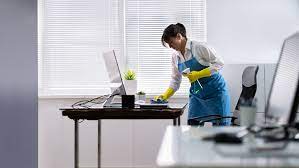Walk into any well-run office and you’ll feel it instantly. Clean floors, fresh air, tidy desks, and bathrooms that don’t make you second-guess your career choices. Professional cleaning isn’t about occasional tidiness—it’s about consistency, strategy, and systems that keep everything running smoothly.
If you’ve ever wondered how commercial cleaners keep offices spotless day after day, this guide breaks down the principles, routines, and techniques that define professional-grade Office Cleaning—and how businesses benefit when they take it seriously.
What Makes Office Cleaning “Professional”?
The difference between casual and professional cleaning isn’t elbow grease—it’s method. Professional office cleaners work from systems. They clean with purpose, based on traffic patterns, material types, hygiene risks, and presentation standards.
A professional Office Cleaning routine includes:
- Daily attention to high-touch areas
- Scheduled deep cleans to prevent build-up
- Safe, effective cleaning products
- Visual checks and checklists to ensure quality
- A focus on health, hygiene, and overall presentation
This structure turns what seems like “simple” cleaning into an essential business service—supporting health, productivity, and brand perception.
Start With a Cleaning Schedule That Works
Professional cleaning isn’t one-size-fits-all. Offices differ in layout, usage, headcount, and industry. But the most effective schedules always share three core components:
1. Daily Cleaning Tasks
These cover the high-traffic, high-risk areas and prevent mess from building up:
- Empty bins and replace liners
- Wipe down desks, phones, and door handles
- Disinfect bathrooms
- Clean kitchen benches and sinks
- Vacuum and mop floors in common areas
2. Weekly and Fortnightly Tasks
These maintain deeper hygiene and presentation:
- Deep-clean fridges and microwaves
- Dust air vents, blinds, and baseboards
- Polish windows and glass doors
- Clean inside rubbish bins
3. Monthly or Quarterly Maintenance
Less frequent, but crucial:
- Carpet steam cleaning
- Floor stripping and resealing (where required)
- Detailed bathroom sanitisation
- Furniture and upholstery cleaning
Businesses that invest in structured Office Cleaning rarely need to deal with complaints—they prevent issues before they start.
The Tools That Professionals Trust
You can’t clean well with worn-out gear. Professional office cleaners rely on tools that are built for efficiency, hygiene, and durability:
- Microfibre cloths: Better at trapping dust and bacteria, and reusable
- Colour-coded equipment: Prevents cross-contamination between areas like bathrooms and kitchens
- HEPA-filter vacuums: Capture fine dust and allergens
- T-bar mops and flat mops: Reduce strain and deliver better coverage
- Eco-friendly sprays and disinfectants: Effective without harming people or surfaces
Most importantly, professional cleaners know how and when to use them. It’s about matching the right tool to the job—and keeping tools themselves clean and maintained.
Focus on the Touchpoints
Professional office cleaning isn’t about cleaning everything—it’s about cleaning the right things, consistently.
That means daily attention to “touchpoints”:
- Light switches
- Lift buttons
- Desk phones
- Printer/copier buttons
- Fridge handles
- Bathroom flush buttons and taps
These are the areas that spread bacteria the fastest and get missed the most during casual wipe-downs. Professionals prioritise them every time.
For reference, this guide from the Australian Government Department of Health highlights just how important surface cleaning is to maintaining a safe and hygienic workplace.
The Hidden Impact of Office Cleaning
It’s easy to underestimate how much cleaning affects daily business performance. But consider the flow-on effects:
- Fewer sick days: Because viruses aren’t spreading via unclean surfaces
- Happier staff: Because no one wants to eat lunch in a grimy kitchen
- Impressed clients: Because the space looks like someone gives a damn
- Improved air quality: Because dust, allergens and bacteria are kept in check
Many businesses report better attendance, higher morale, and even stronger client retention after upgrading their Office Cleaning schedule.
What Makes a Cleaning Provider Stand Out?
If you’re outsourcing, professional doesn’t mean “someone with a mop.” It means a team that brings systems, reliability, and care to the job. Ask these questions before signing a contract:
- Do you offer daily and periodic cleaning options?
- Are your staff background-checked and insured?
- What cleaning products do you use—and are they eco-friendly?
- Do you have a checklist or quality control process?
- Can you clean outside business hours?
Great cleaning providers don’t just remove dirt—they help businesses run better by keeping the workplace safe, consistent and inviting.
Final Word: Clean Like It Matters—Because It Does
Professional Office Cleaning isn’t about doing more—it’s about doing it right. With smart planning, consistent effort and the right tools, your office can become the kind of space people enjoy walking into.
Whether you’re handling cleaning internally or using a commercial service, the principle is the same: structure, consistency, and care lead to better outcomes.
Want to work like a professional? Start by cleaning like one. Your staff, your clients—and your bottom line—will feel the difference.

